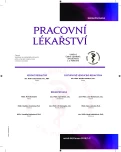Screening of ear in adults by questionnaire
Authors:
E. Mrázková 1,2,3,4; M. Kovalová 1; H. Tomášková 1; J. Janoutová 1; P. Sachová 2,5; E. Záthurecký 2; J. Šichnárek 1,2; K. Vojkovská 2; V. Janout 1
Authors‘ workplace:
Ústav epidemiologie a ochrany veřejného zdraví, Lékařská fakulta Ostravské univerzity
vedoucí pracoviště prof. MUDr. Vladimír Janout, CSc.
1; Centrum pro poruchy sluchu a rovnováhy v Ostravě
vedoucí pracoviště prim. MUDr. Eva Mrázková Ph. D.
2; ORL oddělení NsP Havířov
vedoucí pracoviště prim. MUDr. Eva Mrázková Ph. D.
3; Oddělení pracovního a preventivního lékařství, FNO, Ostrava
vedoucí pracoviště prim. MUDr. Zdeňka Hajduková, Ph. D.
4; Ústav preventivního lékařství, Lékařská fakulta Univerzity Palackého v Olomouci
vedoucí pracoviště doc. MUDr. Helena Kollárová, Ph. D.
5
Published in:
Pracov. Lék., 68, 2016, No. 1-2, s. 33-39.
Category:
Original Papers
Overview
Introduction:
Individuals with hearing defects represent a very heterogeneous group. It is due to the fact that each hearing defect has its own importance and different impact on the person with the defect. The symptoms of hearing loss develop slowly and creepingly. If the hearing defect is not treated, it can deepen and influence the individuality of the person. The aim of this work was to verify, whether the hearing defect can be uncovered in the doctor’s office by a short standardized questionnaire.
Methods:
The observation descriptive study provided information about the health state and hearing threshold of adult responders. The hearing was examined by audiometric examination. The authors examined the mean loss in the dB of the better hearing ear at the 500, 1000, 2000, and 4000 Hz frequencies. Each patient filled out the questionnaire concerning subjective perception of hearing handicap Hearing Handicap Inventory (HHI) kin a shortened version with 10 questions. The data were described by basic descriptive statistics. The statistical tests were evaluated at the 5% level of significance.
Results:
The group included 27,713 persons, 52.8% of the women (SD = 17.5). The mean age was 53.9 (SD = 18.88). The average hearing loss according to tone audiometry up to 25 dB affected 67.74% of individuals, light hearing loss (hardness of hearing) affected 20.38% of subjects. The average hearing losses of 41–68 dB were determined in 10.44%, the losses of 61–80 dB were in 1.23 of subjects and over 80dB affected 0.23% of the responders. There was a significant positive relationship between resulting score of hearing handicap and average losses according to tone audiometry on the better hearing ear, rs = 0.739 (p < 0.001).
The sensitivity of HHI in responders with average hearing loss more than 41dB was 93% and sensitivity was 80%. The abbreviated version of HHI revealed that the risk of hearing handicap increases with age. In case of a rough the risk is higher for women and for persons working in a noisy environment.
After adjustment the risk of hearing handicap is significantly higher for men and it was also higher for persons working in the noisy environment.
Conclusion:
Hearing Handicap Inventory (HHI) appears to be a possible screening tool to uncover hearing problems within the framework of preventive examinations by family physician. It is a simple, cheap and not time-consuming test, which determines emotional and social impact of hearing loss in common daily activities. A timely diagnosis and therapy of hearing loss could help to many persons with hearing defects to maintain a good quality of life for a longest possible period of time
Keywords:
hearing screening – adults – hard of hearing – sensitivity – specificity – Hearing Handicap Inventory (HHI)
Sources
1. Aiello, C. P., de Lima, I. I., Ferrari, D. V. Validity and reliability of the hearing handicap inventory for adults. Brazilian Journal of Otorhinolaryngology, 2011, 77, 4, s. 432–438. Dostupné na www: http://www.scielo.br/pdf/bjorl/v77n4/v77n4a05.pdf
2. Blanař, V., Mejzlík, J., Pellant, A., Bártová, I., Krčmář, P., Lovas, M. Česká verze dotazníku hearing handicap inventory for adults. Otorinolaryng. Foniat., 2014, 63, 1, s. 50–56.
3. Monzani, D., Genovese, E., Palma, S., Rovatti, V., Borgonzoni, M., Martini, A. Measuring the psychosocial consequences of hearing loss in a working adult population: focus on validity and reliability of the Italian translation of the hearing handicap inventory.
Acta otorhinolaryngologica Italica: organo ufficiale della Società italiana di otorinolaringologia e chirurgia cervico-facciale, 2007, 27, 4, s. 186–191.
4. Newman, C. W., Weinstein, B. E., Jacobson, G. P., Hug, G. A. The hearing handicap inventory for adults: Psychometric adequacy and audiometric correlates. Ear and Hearing, 1990, 11, 6, s. 430–433.
5. Newman, C. W., Weinstein, B. E., Jacobson, G. P., Hug, G. A. Test-retest reliability of the hearing handicap inventory for adults. Ear and Hearing, 1991, 12, 5, s. 355–357.
6. Olusanya, B. O., Neumann, K. J., Saunders, J. E. The global burden of disabling hearing impairment: a call to action Bull World Health Organ. 2014, 92, 5, s. 367–373. Published online 2014. doi: 10.2471/BLT.13.128728.
7. Smith A. W. Preventing deafness – an achievable challenge. The WHO perspective. Int Congr Ser, 2003, 1240, s. 183–191. Dostupné na www: http://dx.doi.org/10.1016/S0531-5131(03)00960-9.
8. Smith, A. W. WHO activities for prevention of deafness and hearing impairment in children. Scand Audiol., 2001, 53, Suppl, s. 93–100. Dostupné na www: http://dx.doi.org/10.1080/010503901750166808 pmid: 11409786.
9. World health organization Deafness and hearing loss. [online]. 2015 [cit. 2015-03-10]. Dostupné na www: http://www.who.int/mediacentre/factsheets/fs300/en/.
10. World Health Organization. Prevention of blindness and deafness. Geneva. Dostupné na www: http: //www.who.int/pbd/deafness/hearing_impairment_grades/en.
11. World Health Organization. WHO global estimates on prevalence of hearing loss. Geneva, 2012. Dostupné na www: http://www.who.int/pbd/deafness/estimates.
Labels
Hygiene and epidemiology Hyperbaric medicine Occupational medicineArticle was published in
Occupational Medicine

2016 Issue 1-2
Most read in this issue
- The application of treatment with ionized oxygen in occupational medicine
- Impact of skin temperature on the screening electromyography results within the occupational medical examinations
- The relationship between psychological safety and burnout among nurses
- Screening of ear in adults by questionnaire
